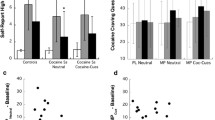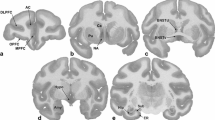Abstract
Cocaine and cocaethylene (a psychoactive metabolite of concurrent cocaine and ethanol consumption) were studied in the anesthetized vervet monkey. The ability of each to elevate extracellular DA in the caudate nucleus was assessed using microdialysis probes acutely lowered through chronic guide cannulae. Blood samples were also collected to determine plasma levels of the two drugs. Doses of 1.5 µmol/kg cocaine (equivalent to 0.5 mg/kg cocaine-HC1) and cocaethylene were administered intravenously. Microdialysis and blood samples were collected at 5-min intervals immediately following drug administration. Both drugs caused a maximal four-fold increase in extracellular DA during the 5- to 10-min period following drug administration. This is the first report of cocaine (and cocaethylene) induced alterations in extracellular DA in primates. The abilities of cocaine and cocaethylene to produce euphoria are being compared in ongoing clinical research studies. The potential use of these results for interpreting the neurochemical basis of any differences in those studies is discussed.
Similar content being viewed by others
References
Bailey DN (1993) Plasma cocaethylene concentrations in patients treated in the emergency room or trauma unit. Am J Clin Pathol 99:123–127
Benveniste H, Hansen AJ, Ottosen NS (1989) Determination of brain interstitial concentrations by microdialysis. J Neurochem 52:1741–1750
Boyer GS, Petersen DR (1992) Enzymatic basis for the transesterification of cocaine in the presence of ethanol: evidence for the participation of microsomal carboxyesterases. J Pharmacol Exp Ther 260:939–946
Bradberry CW, Roth RH (1989) Cocaine increases extracellular dopamine in rat nucleus accumbens and ventral tegmental area as shown by in vivo microdialysis. Neurosci Lett 103:97–102
Bradberry CW, Sprouse JS, Aghajanian GK, Roth RH (1991) Subpicogram determination of serotonin using HPLC with electrochemical detection for microdialysis studies. In: Schwarcz RX, Young SN, Brown RR (eds) Kynurenine and serotonin pathways, Plenum Press, New York
Bradberry CW, Nobiletti JB, Elsworth JD, Murphy B, Jatlow P, Roth RH (1993) Cocaine and cocaethylene: microdialysis comparison of brain drug levels and effects on dopamine and serotonin. J Neurochem 60:1429–1435
Cunningham KA, Callahan PM (1991) Monoamine reuptake inhibitors enhance the discriminative state induced by cocaine in the rat. Psychopharmacology 104:177–180
Dean RA, Christian CD, Sample RHB, Bosron WF (1991) Human liver cocaine esterases: ethanol-mediated formation of cocaethylene. FASEB J 5:2735–2739
Elsworth JD, Lawrence MS, Roth RH, Taylor JR, Mailman RB, Nichols DE, Lewis MH, Redmond D Jr (1991) D1 and D2 dopamine receptors independently regulate spontaneous blink rate in the vervet monkey. J Pharmacol Exp Ther 259:595–600
Elsworth JD, Taylor JR, Jatlow P, Roth RH (1993) Serotonin involvement in cocaine sensitization: clues from studies with cocaine analogs. Drug Dev Res 30:189–200
Gaspar P, Berger B, Febvret A (1990) Neurotensin innervation of the human cerebral cortex: lack of colocalization with catecholamines. Brain Res 530:181–195
Haycock JW (1991) Four forms of tyrosine hydroxylase are present in human adrenal medulla. J Neurochem 56:2139–2142
Hearn WL, Flynn DD, Hime GW, Rose S, Cofino JC, E. EM-A, Wetli CV, Mash DC (1991) Cocaethylene. A unique cocaine metabolite displays high affinity for the dopamine transporter. J Neurochem 56:698–701
Jansen KL, Faull RL, Dragunow M, Leslie RA (1991) Distribution of excitatory and inhibitory amino acid, sigma, monoamine, catecholamine, acetylcholine, opioid, neurotensin, substance P, adenosine and neuropeptide Y receptors in human motor and somatosensory cortex. Brain Res 566:225–238
Jatlow P, Nadim H (1990) Determination of cocaine concentrations in plasma by high-performance liquid chromatography. Clin Chem 36:1436–1439
Jatlow P, Elsworth JD, Bradberry CW, Winger G, Taylor JR, Russel, Roth RH (1991) Cocaethylene: a neuropharmacologically active metabolite associated with concurrent cocaine-ethanol ingestion. Life Sci 48:1787–1794
Javaid JI, Fischman MW, Schuster CR, Dekirmenjian H, Davis JM (1978) Cocaine plasma concentration: relation to physiological and subjective effects in humans. Science 202:227–228
Johnson RD, Justice JB (1983) Model studies for brain dialysis. Brain Res Bull 10:567–571
Katz JL, Terry P, Witkin J (1992) Comparative behavioral pharmacology and toxicology of cocaine and its ethanol-derived metabolite, cocaine ethyl-ester (cocaethylene). Life Sci 50:1351–1361
Kleven MS, Anthony EW, Woolverton WL (1990) Pharmacological characterization of the discriminative stimulus effects of cocaine in rhesus monkeys. J Pharmacol Exp Ther 254:312–317
Kleven MS, Woolverton WL (1993) Effects of three monoamine uptake inhibitors on behavior maintained by cocaine or food presentation in rhesus monkeys. Drug Alcohol Depend 31:149–158
Lin MF, McGuire PS, Brown KA, Evans MA, Christian CD, Harper ET, Bosron WF (1989) Formation of the active metabolite cocaethylene from ethanol and cocaine in freshly isolated rat hepatocytes. Pharmacologist 31:229A
Loh EA, Roberts DCS (1990) Break-points on a progressive ratio schedule reinforced by intravenous cocaine increase following depletion of forebrain serotonin. Psychopharmacology 101:262–266
Lyness WH, Friedle NM, Moore KE (1979) Destruction of dopaminergic nerve terminals in nucleus accumbens: effect ond-amphetamine self-administration. Pharmacol Biochem Behav 11:553–556
McCance-Katz EF, Price LH, McDougle CJ, Kosten TR, Black JE, Jatlow PI (1993) Concurrent cocaine-ethanol ingestion in humans: pharmacology, physiology, behavior, and the role of cocaethylene. Psychopharmacology 111:39–46
McCance-Katz EF, Price LH, Kosten TR, Jatlow PI (1995) Cocaethylene: pharmacology, physiology, and behavioral effects in humans. J Pharmacol Exp Ther (in press)
Nobiletti JB, Jatlow PI, Bradberry CW (1994) Differences in bioavailability between cocaine and cocaethylene and their implications for drug-reward studies. Psychopharmacology 116:273–278
Parsons LH, Justice J Jr (1992) Extracellular concentration and in vivo recovery of dopamine in the nucleus accumbens using microdialysis. Neurochem 58:212–218
Perez-Reyes M (1993) Subjective and cardiovascular effects of cocaethylene in humans. Psychopharmacology 113:144–147
Perez-Reyes M, Jeffcoat RA (1992) Ethanol/cocaine interaction: cocaine and cocaethylene plasma concentrations and their relationship to subjective and cardiovascular effects. Life Sci 51:553–563
Perez-Reyes M, Jeffcoat AR, Myers M, Sihler K, Cook CE (1994) Comparison in humans of the potency and pharmacokinetics of intravenously injected cocaethylene and cocaine.
Pettit HO, Justice J Jr (1989) Dopamine in the nucleus accumbens during cocaine self-administration as studied by in vivo microdialysis. Pharmacol Biochem Behav 34:899–904
Rafla FK, Epstein RL (1979) Identification of cocaine and its metabolites in human urine in the presence of ethyl alcohol. J Anal Toxicol 3:59–63
Roberts DCS, Koob GF (1982) Disruption of cocaine self-administration following 6-hydroxydopamine lesions on the ventral tegmental area in rats. Pharmacol Biochem Behav 17:901–904
Roberts DCS, Corcoran ME, Fibiger HC (1977) On the role of ascending catecholaminergic systems in intravenous self-administration. Pharmacol Biochem Behav 6:615–620
Roberts DCS, Koob GF, Klonoff P, Fibiger HC (1980) Extinction and recovery of cocaine self-administration following 6-hydroxydopamine lesions of the nucleus accumbens. Pharmacol Biochem Behav 12:781–787
Roberts DCS, Loh EA, Baker GB, Vickers G (1994) Lesions of central serotonin systems affect responding on a progressive ratio schedule reinforced either by intravenous cocaine or by food. Pharmacol Biochem Behav 49:177–182
Rounsaville BJ, Anton SF, Carroll K, Budde D, Prusoff BA, Gawin F (1991) Psychiatric diagnoses of treatment-seeking cocaine abusers. Arch Gen Psychiatry 48:43–51
Saunders RC, Aigner TG, Frank JA (1990) Magnetic resonance imaging of the rhesus monkey brain: use for stereotactic neurosurgery. Exp Brain Res 81:443–446
Smith RM (1984) Ethyl esters of arylhydroxy- and arylhydroxymethoxycocaines in the urines of simultaneous cocaine and ethanol users. J Anal Toxicol 8:38–42
Snoddy AM, Tessel RE (1985) Prazosin: effect on psychomotor-stimulant cues and locomotor activity in mice. Eur J Pharmacol 116:221–228
Teoh SK, Sarnyai Z, Mendelson JH, Mello NK, Springer SA, Sholar JW, Wapler M, Kuehnle JC, Gelles H (1994) Cocaine effects on pulsatile secretion of ACTH in men. J Pharmacol Exp Ther 270:1134–1138
Walsh SL, Preston KL, Sullivan JT, Fromme R, Bigelow GE (1994) Fluoxetine alters the effects of intravenous cocaine in humans. J Clin Psychopharmacol 14:396–407
Wang J, Skirboll S, Aigner TG, Saunders RC, Hsiao J, Bankiewicz KS (1990) Methodology of microdialysis of neostriatum in hemiparkinsonian nonhuman primates. Exp Neurol 110:181–186
Wise RA, Bozarth MA (1987) A psychomotor stimulant theory of addiction [review]. Psychol Rev 94:469–492
Woodward JJ, Mansbach R, Carroll FI, Balster RL (1991) Cocaethylene inhibits dopamine uptake and produces cocaine-like actions in drug discrimination studies. Eur J Pharmacol 197:235–236
Author information
Authors and Affiliations
Rights and permissions
About this article
Cite this article
Iyer, R.N., Nobiletti, J.B., Jatlow, P.I. et al. Cocaine and cocaethylene: Effects on extracellular dopamine in the primate. Psychopharmacology 120, 150–155 (1995). https://doi.org/10.1007/BF02246187
Received:
Revised:
Issue Date:
DOI: https://doi.org/10.1007/BF02246187




